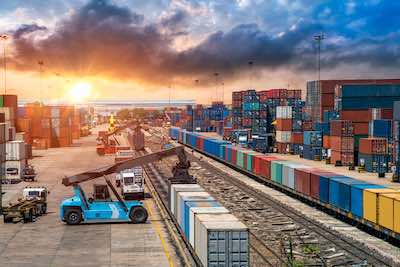
Supply chains are in trouble. A lot of trouble. With the holiday season drawing near, consumers are concerned about the impact on their holidays and wondering when the shortages will finally end. As the faculty director for the Master’s in Supply Chain Management program at the Georgetown University School of Continuing Studies, I often start my classes with a quote by Albert Einstein: “You can never solve a problem with the same kind of thinking that created the problem in the first place.”
The reality is that our global supply chain woes didn’t start during the pandemic; the pandemic just stoked the embers of existing issues into one great roaring fire. This situation is also not just a supply issue. An increase in demand for goods versus services, acceleration of the digitization of products, and a rebounding economy all play a role. In fact, a September press release from the National Retail Federation (NRF) indicates that “for the first eight months of the year, sales as calculated by NRF were up 15 percent over the same period in 2020.” Likewise, Mastercard SpendingPulse “anticipates U.S. holiday retail sales to grow 7.4 percent in 2021.”
Supply Chain Struggles
Certainly, the pandemic is a core reason for the dearth in the supply of many goods. Most recently, the COVID-19 lockdowns and travel restrictions in Southeast Asia slowed production and shipments to the United States. Global and domestic outbreaks have also increased the shortage of workers in warehouses and plants and exacerbated the existing domestic driver shortage.
With that said, many supply chain issues are years in the making. Port congestion, lack of warehouse space, a deficit of equipment, constrained semiconductor chip supply, over-centralization of sourcing, a hyper-focus on cost-cutting, poor visibility beyond Tier 1 suppliers, and a significant U.S. import/export imbalance are some of the longer-term issues. Now add in China’s recent power outages, which according to a manager quoted in a September article in Nikkei Asia have occurred “since this June, but it has become a regular thing since mid-September,” and the house is truly on fire!
Worker Shortages Expected To Continue
So that leaves the question: Who will be the hardest hit these holidays?
Likely it is supply chain workers. They’ve already run a “supply chain marathon” for over a year and a half, albeit without the crowds or sometimes even their own leadership cheering them on. Since the holiday season is peak time for supply chains, the additional strain on workers is a great risk for global supply chains.
On September 30, 2021, supply chain and transport heads released a joint open letter asking the world's heads of government and the United Nations Agencies to address the global supply chain crisis and its impact on transport workers. Likewise, an October 8 article in the Wall Street Journal highlighted the distressing situation about an increase of crews on abandoned ships without pay or supplies.
Fortunately, there is some progress in prioritizing supply chain workers. Greg Hofe, a faculty member teaching in our Supply Chain Management master’s program, summed it up well when he stated, “The importance of the supply chain in today’s global markets has increased to a new level. Organizations are adding senior-level management staff (where few or none have existed in the past) to handle the new pressures of increased costs, complexity, multiple channels, near-immediate delivery, unplanned demand, and volatility.”
Likely it will take time, talented future supply chain leaders, and new thinking to solve some of the deep-rooted, systemic problems. In the near term, we can acknowledge and address the growing strain on workers. In addition to the measures issued in the joint open letter, potential actions like giving free access to mental health resources, providing childcare and eldercare support, ensuring appropriate levels of pay, curbing excessive overtime, and providing recognition would help.
The holidays will soon be upon us and implementing a few of these measures would certainly increase the holiday spirit within the supply chain ranks. As one of my mentors used to remind me, “In the end, it’s really all about people.”

